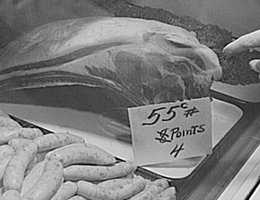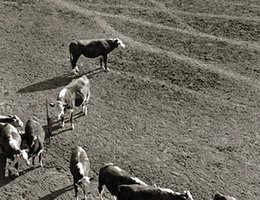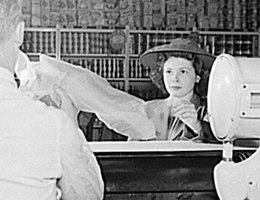

This tangle of economics resulted in a shortage of beef. That, in turn, created a lucrative black market for beef.
The black market avoided price controls at every level of production. Unscrupulous cattle buyers paid ranchers more for cattle that they bought straight from the fields, thus avoiding public sales and inevitable price ceilings. Packers bought the extra cattle, butchered them, and then offered them to meat markets with empty shelves. They asked for the ceiling price plus some extra money under the table. The meat market would then hold back the extra meat for customers who were willing to buy it at a premium price, so a customer might pay one dollar a pound for black market meat when the legal price was just 60 cents.

As Nebraska herds came to weight in the Sandhills pastures, many ranchers were forced to hold them because current ceiling prices were less than the cost of production. In short, ranchers couldn’t afford to sell their cattle. So while there was a meat shortage on the east and west coasts, in Nebraska there was a glut of cattle.
Winn Nelson, a writer for the Lincoln Journal, wrote an article entitled, Beef Plentiful ‘Out Where West Begins’:
"Countless herds of big steers having beef to the hocks darken the rolling hills. . . . The herds are a sight which might panic a beef-starved New Yorker, as he remembers that in his city the department of agriculture [sic] posts each day not only regular ceiling prices but also black market prices of meat. . . ." –February 20, 1944, section D page 1

But worse, grass-fed beef is very lean, and there was a real shortage of the tender, marbled, corn-fed beef that Americans loved so much. So a second version of the black market emerged where feeders would pay higher prices for cattle that had not been fed on grass. They would then pay high corn prices and fatten the cattle, and in turn sell to packing houses that would pay premium, above-ceiling prices for the corn-fed animal. And the packing houses, in turn, would sell the succulent, marbled beef to retailers with customers ready and willing to pay a premium for a prime steak.
From this black market emerged new rural steakhouses located away from government scrutiny that offered high quality steaks for an equally high price. As Winn Nelson noted:
"Most Lincolnites have observed that a short trip past the outskirts of a metropolitan center usually brings them to a not-so-well-lighted roadhouse where steaks are featured on the menu with large dollar signs."